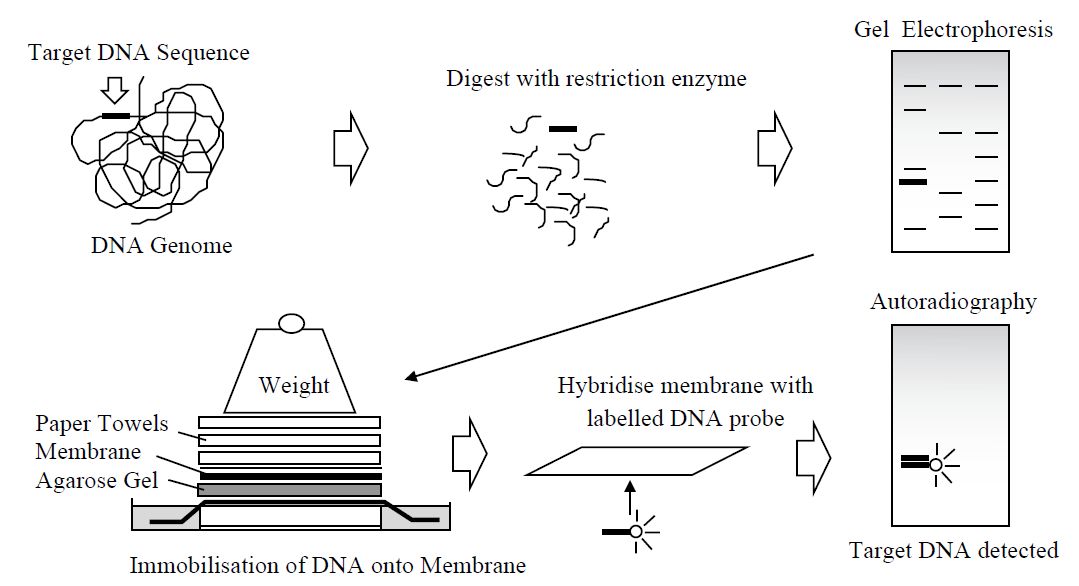
Nucleic acid analysis methods
 المؤلف:
John M Walker and Ralph Rapley
المؤلف:
John M Walker and Ralph Rapley
 المصدر:
Molecular Biology and Biotechnology 5th Edition
المصدر:
Molecular Biology and Biotechnology 5th Edition
 الجزء والصفحة:
الجزء والصفحة:
 6-11-2020
6-11-2020
 2491
2491
Nucleic acid analysis methods
There are numerous methods for analysing DNA and RNA; however, many of them are solution based or more recently include the use of chip-based array systems. Indeed, the lab-on-a-chip approach is developing rapidly and it is possible to envisage many detection and analysis methods being developed in this format in the future.However, traditional methods are still employed in many laboratories and much is still made of producing a hard copy of digested and separated singlestranded DNA fragments attached to a matrix such as nylon for analysis with an appropriate labelled probe.
1- DNA Blotting
Electrophoresis of DNA restriction fragments allows separation based on size to be carried out; however, it provides no indication as to the presence of a specific, desired fragment among the complex sample (Figure 1). This can be achieved by transferring the DNA from the intact gel on to a piece of nitrocellulose or nylon membrane placed in contact with it. This provides a more permanent record of the sample since DNA begins to diffuse out of a gel that is left for a few hours. First the gel is soaked in alkali to render the DNA single stranded. It is then transferred to the membrane so that the DNA becomes bound to the it in exactly the same pattern as that originally on the gel. This transfer, named a Southern blot after its inventor Ed Southern, can be performed electrophoretically or by drawing large volumes of buffer through both gel and membrane, thus transferring DNA from one to the other by
 Figure 1. The steps involved in the production of a Southern blot and the subsequent
Figure 1. The steps involved in the production of a Southern blot and the subsequent
detection of a specific DNA sequence following hybridisation with a complementary labelled gene probe.
capillary action. The point of this operation is that the membrane can now be treated with a labelled DNA molecule, for example a gene probe. This single-stranded DNA probe will hybridise under the right conditions to complementary fragments immobilised on the membrane.
The conditions of hybridisation, including the temperature and salt concentration, are critical for this process to take place effectively. This is usually referred to as the stringency of the hybridisation and it is particular for each individual gene probe and for each sample of DNA. A series of washing steps with buffer are then carried out to remove any unbound probe and the membrane is developed, after which the precise location of the probe and its target may be visualised. It is also possible to analyse DNA from different species or organisms by blotting the DNA and then using a gene probe representing a protein or enzyme from one of the organisms. In this way, it is possible to search for related genes in different species. This technique is generally termed Zoo blotting.
2- RNA Blotting
The same basic process of nucleic acid blotting can be used to transfer RNA from gels on to similar membranes. This allows the identification of specific mRNA sequences of a defined length by hybridisation to a labelled gene probe and is known as Northern blotting. With this technique it is not only possible to detect specific mRNA molecules but it may also be used to quantify the relative amounts of the specific mRNA. It is usual to separate the mRNA transcripts by gel electrophoresis under denaturing conditions since this improves resolution and allows a more accurate estimation of the sizes of the transcripts. The format of the blotting may be altered from transfer from a gel to direct application to slots on a specific blotting apparatus containing the nylon membrane. This is termed slot or dot blotting and provides a convenient means of measuring the abundance of specific mRNA transcripts without the need for gel electrophoresis; it does not, however, provide information regarding the size of the fragments.
A further method of RNA analysis that overcomes the problems of RNA blotting is termed the ribonuclease protection assay. Here the RNA from a sample is extracted and then mixed with a probe representing the sequence of interest in solution. The probe and the appropriate RNA fragment hybridise to form a double-stranded sequence.
RNase is then added, which cleaves any single-stranded RNA present but leaves the double-stranded RNA intact. The intact RNA can then be separated by electrophoresis and an indication of the size of the fragment generated. The efficient removal of the background of RNA and the improved sensitivity make the ribonuclease protection assay a popular choice for the analysis of specific RNA molecules. An important step in the field of RNA analysis was the development of RNAi (RNA interference), which inhibits gene expression. Here double-stranded DNA promotes the degradation of mRNA. Doublestranded RNA in the cell is cleaved by a dicer enzyme, resulting in the
formation of small 21–25 bp interfering RNAs (siRNA). The siRNA are complementary to a target RNA strand. Small RNAi proteins are guided by the siRNA to the appropriate mRNA, where the target is then cleaved and is unable to be translated. Many areas are now benefiting from the adoption of this technique in the molecular biology and biotechnology fields.
 الاكثر قراءة في مواضيع عامة في الاحياء الجزيئي
الاكثر قراءة في مواضيع عامة في الاحياء الجزيئي
 اخر الاخبار
اخر الاخبار
اخبار العتبة العباسية المقدسة


